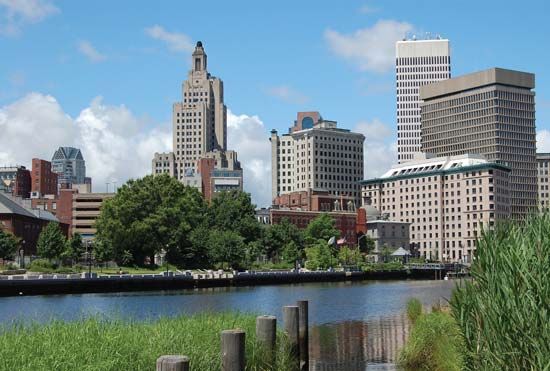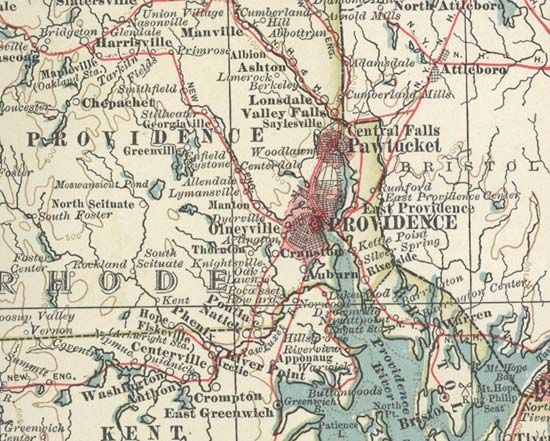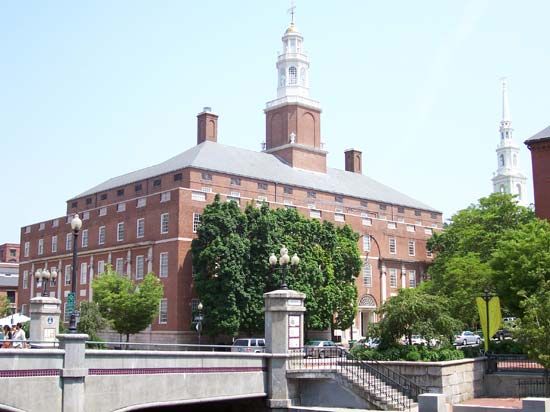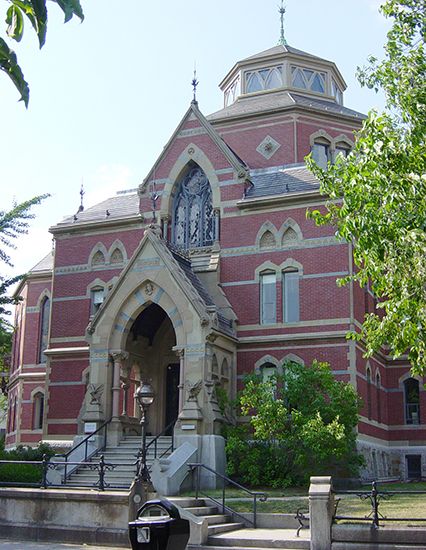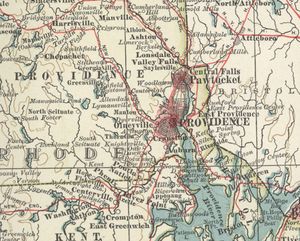Providence
Providence, city, capital of Rhode Island, U.S. It lies in Providence county at the head of Narragansett Bay on the Providence River. A seaport and an industrial and commercial centre, it is the focus of a metropolitan area that includes Pawtucket, East Providence, Central Falls, Cranston, Warwick, and Woonsocket. It was founded in 1636 by Roger Williams, who had been banished from Massachusetts Bay colony for his unorthodox religious beliefs. Williams and five Dissenter companions, after canoeing along the Moshassuck River to what is now called College Hill, found a freshwater spring. From the Narragansett sachems Canonicus and Miantonomi he purchased the surrounding land, which he named for “God’s merciful providence.” The settlement’s growth, halted by King Philip’s War (1675–76), was given impetus in 1680, when Pardon Tillinghast built a wharf that became a base for the thriving triangular trade in molasses, slaves, and rum between Africa, the West Indies, and the American colonies.
Providence played an important role in the American Revolution; it had its own “Tea Party,” at which tea was burned in protest against taxation. Forts were built in the town, and American and French troops were quartered in what is now University Hall (built 1770; restored 1940) at Brown University. The Old State House (1762) was the scene of the signing of the Rhode Island Independence Act (May 4, 1776) two months in advance of the country’s own Declaration of Independence. In the post-Revolutionary period Providence’s sea trade quickly recovered. By the late 19th century it was supplemented by industrial activity, which today includes the manufacture of machinery and machine tools, jewelry, plastics, electronic equipment, and rubber goods. Providence remains a busy seaport and is a distributing point for oil, natural gas, lumber, steel, and chemicals.
Providence was incorporated as a city in 1831 and became sole capital of Rhode Island in 1900, after having shared the duty first with four other towns and from 1854 with Newport. The city contains much of historic interest. The names of many streets (e.g., Benefit, Benevolent, Hope, Friendship, Dubloon, India, Packet, and Ship) are reminders of the community’s early search for religious toleration and of its maritime commerce. Other colonial landmarks include the Meeting House of the First Baptist Church (1775), the oldest Baptist church in the United States; the Market House (1773); and the John Brown House (1786), a Georgian-style mansion and national historic landmark. The First Unitarian Church (1816) has the largest bell cast by Paul Revere.

Educational institutions include Brown University (founded in 1764 in Warren as Rhode Island College, moved to Providence in 1770, and renamed in 1804 for Nicholas Brown, its principal benefactor), Johnson and Wales University (1914), the Rhode Island School of Design (1877), Rhode Island College (established in 1854 as Rhode Island State Normal School), and Providence College (1917, Roman Catholic). The Museum of Art of the Rhode Island School of Design has collections of American decorative arts and European paintings. The Providence Athenaeum (1838) houses a collection (established 1753) of old books and paintings. The State House (1895–1900), built of white Georgia marble, has a dome measuring 50 feet (15 metres) in diameter. The city has two cathedrals, SS. Peter and Paul (1874–89, Roman Catholic) and St. John (1810, Episcopal).
Severe damage was caused by a hurricane and storm surge in 1938, and, as a protection, the Fox Point Hurricane Barrier was completed in 1966. Renovations to the city in the late 20th century included uncovering and rerouting the two downtown rivers that had been paved over and constructing a new civic centre. Pop. (2010) 178,042; Providence–New Bedford–Fall River Metro Area, 1,600,852; (2020) 190,934; Providence–Warwick Metro Area, 1,676,579.

